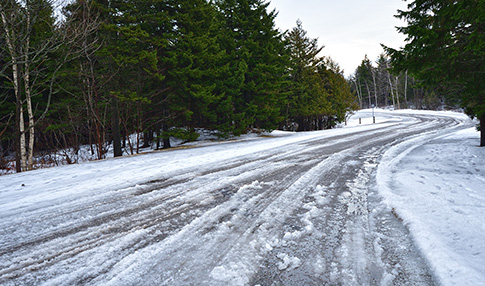How to avoid hydroplaning

Melting snow or heavy rain—as soon as water starts to accumulate on the road, there is a risk of hydroplaning and losing control of your vehicle. What are the warning signs? How do you avoid it? Get the lowdown and some tips from our experts.
What conditions are conducive to hydroplaning?
Hydroplaning can occur anywhere that water accumulates, including:
- High-traffic roads with ruts where water can build up
- Between two consecutive bends where the road doesn’t slope in either direction and water has nowhere to go
- In heavy rain
- Where meltwater or rainwater runs onto the road
- When slush accumulates on the road

What are the warning signs of traction loss?
A keen eye can see it coming when the tracks left by the vehicle in front of you disappear right behind it. Or if the vehicle sprays large amounts of water off to the sides.
You’ll know you’re in danger when:
- You have the unpleasant feeling that the front wheels don’t have any traction when steering or braking
- The engine rpm increases without exerting any additional pressure on the gas pedal (less pronounced in rear-wheel drive vehicles)
- You hear loud noises made by water in your wheel wells
5 tips to avoid hydroplaning
Slow down
You’ll reduce the risk of hydroplaning by slowing down when it rains or you suspect there are puddles on the road. Tires rotating at high speeds on wet pavement need to move a lot of water very fast to stay in contact with the road. Doubling the safety distance between you and the vehicle in front of you is strongly recommended. You should adapt your driving to the road conditions all year long.
Avoid using cruise control on wet roads
Forget cruise control when the road is slippery and/or wet in summer or winter. Why? If the vehicle hydroplanes while cruise control is engaged, the wheels will accelerate when they should be slowing down. You could lose control. Plus, people tend to keep their feet farther away from the pedals when using cruise control, which will increase reaction time if you do lose control.
Avoid ruts
Drive slowly around ruts or pools of water, which are usually located on the edge of the road. You could skid!
Monitor tire wear
Worn out tires with too little tread or tread depth move less water less efficiently and increase the risk of hydroplaning. To maintain contact with the road, tires have to spread water—which forms a more or less thick layer on the road—to the front, back, and especially the sides. If the water can’t be moved, waves will form in front of the tires. The tires will tend to lift off the pavement and ride the waves, which function a bit like freezing rain.
Did you know? You should always make sure your tires are inflated to the pressure recommended by the manufacturer. It’s an important factor in ensuring optimal water flow through the tread grooves. It’s also important to note that wide tires hydroplane faster than narrow ones.
Avoid puddles
If you have to go through a puddle, brake before you enter it. It’s not uncommon for vehicles to hit large potholes hidden in puddles. In addition to skidding, you could damage your wheels.
Avoid splashing pedestrians
Go easy on the gas and slow down as you approach puddles when driving in the city. Nobody wants an ice-cold shower!
How to maintain control if you start to skid
If, despite your best efforts, your vehicle starts to skid, hold the steering wheel firmly and keep the wheels pointed in the direction you want to go. Then take your foot off the gas. That will put weight back on the front wheels, making it easier to regain contact with the pavement. If you’re comfortable with this manoeuvre, shift into neutral and brake lightly, without fully blocking the wheels. When the tires are back on the road, you can shift into gear and speed up again. If you lose control completely, the best thing to do is point the wheels in a straight line and engage the brakes fully until the car comes to a stop. Driving in winter? Check out our tips for driving on icy roads.

Benefit from personalized advice
Do you have questions about gas-powered or electric vehicles, driving, or need recommendations to find an Approved Auto Repair Service?